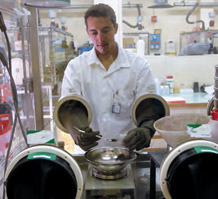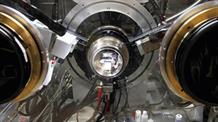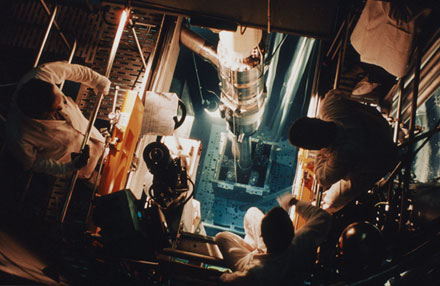Answering an expression of needs
It all starts with someone expressing a need. First of all, we must ask ourselves what will be the purpose of the reactor? If it is to produce electricity, the fuel will be working continuously and we will need to focus on the power and compactness of the core. If it is intended for research, requiring a succession of stops and starts and therefore a good level of heat exchanges, the fuel should ideally be made in plates rather than rods. For example, the future Jules Horowitz Reactor (JHR) will use curved plates assembled into concentric cylinders. Similarly, the design of future FR fuels involves significant innovation. To meet the requirements of the Advanced Sodium Technological Reactor for Industrial Demonstration called Astrid, an integrated design-sizing-simulation approach allowed the CEA to recommend highly innovative patented objects, especially in terms of passive safety1.
Specific studies on the composition of fuel materials
In the case of fuels in the existing PWR fleet, the material is also mature for innovation, as Bruno Collard, head of laboratory at the CEA, explained : "Manufacturers are asking us to improve performance while increasing safety margins.” So, to increase the proportion of fissile uranium, and hence the lifespan, researchers thought of implanting atoms of boron or gadolinium2 capable of absorbing surplus neutrons in the new fuel. This means maintaining the balance between the power released and neutron absorption for as long as possible. Another challenge is to reduce unwanted emissions of fission gases, mainly by increasing the size of the grains so the gases have to travel further to escape.
1 Which acts simply due to the natural effects of the process (gravity, thermal expansion), and does not need I&C or a power supply.
2 Burnable poisons.

Weighing powders in a glove box in the UO2 laboratory at Cadarache © CEA

X-ray diffraction machine, unique in Europe, has taken five years to develop and characterise the actinide materials © CEA
To do this, researchers suggested incorporating additional elements such as chromium or niobium which can, in addition, offer the advantage of reducing the corrosiveness of certain fission products. "Conversely, it is more complicated to make, and therefore more expensive. We therefore need to be sure that innovation is worthwhile. As a general rule, the final concept always ends up being a compromise" admitted Bruno Collard. Thus uranium oxide was chosen because, although its thermal conductivity is not the highest, it demonstrates excellent stability under irradiation, hardly swells at all and has proven easy to produce.
Traditional fabrication processes that are nonetheless suited to specific environments
Once the concept has been defined, the fuel has to be made so it can be tested. The CEA teams have specialist know-how in this field: "Our aim is not just to manufacture the fuel, but also to characterise it at all stages of the process" summarises Meryl Brothier, head of service at the CEA Nuclear Division Energy. "We can go from a few grams to several hundred, which is the lower limit on an industrial scale" says he, emphasising the need to develop fabrication processes on an industrial scale. Even more so given the fact that the handling conditions are not the same depending on the type of fuel: "working with plutonium calls for careful management and additional precautions, that of uranium".
In both cases, operations proceed in the same way: preparation of the initial powders (grinding, mixing, sieving), press forming (to obtain pellets), sintering in a furnace with a controlled atmosphere, and geometric grinding if necessary. In short, the traditional way ceramics are made! "Several people here have studied ceramics in Limoges" said Philippe Prené, director of the Fuel Studies Department at the CEA.
Characterisation tools for optimised quality checks
From the raw material to the end product, everything must be precisely characterised. Researchers therefore have a whole battery of sophisticated tools, which differentiate the laboratory from an industrial-scale facility: differential thermogravimetric analyses, dilatometers, ceramography. There is also an X-ray diffraction device which is unique in Europe and can determine the crystalline structure of a material at temperatures up to 1,800°C-2,000°C depending on the atmosphere under consideration.
Fuel fabrication is then complete. It still needs to be qualified, by irradiating pellets in a device, and the results of this experiment written up.
3 One of the Soleil synchrotron lines at Saclay, called Mars, is now dedicated to nuclear materials and fuels.
Fuel designed to withstand irradiation
Different approaches coexist for testing the effects of irradiation on fuels. One of them consists in placing pellets or even rods in a real reactor (an experimental one such as Cabri, Phébus and soon the JHR, or from the nuclear power plant fleet). This will improve our overall knowledge of how the fuel behaves in a typical situation (required by the nuclear safety authorities). Yet as it is also important to be able to explain the cause of effects, other instrumented experiments are required.
A complementary approach uses "separate effect" experiments. These involve subjecting fresh fuel to ion implantation/irradiation (on accelerators such as JANNuS at Saclay or Ganil in Caen) to reproduce the presence of fission products and irradiation effects, or placing it in a furnace to explore the specific temperature effects. Combined with cutting-edge characterisation tools, such as synchrotron radiation
3, these experiments can be used to survey the core of the material.

Phebus reactor © CEA-IPSN